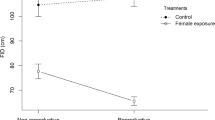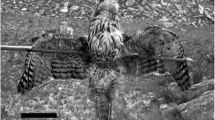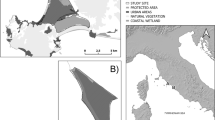Abstract
Flight initiation distance, the predator–prey distance when escape begins, is predicted by escape theory to decrease if fleeing entails loss of benefits. Shortening of flight initiation distance during social interactions is known only in males and only in a few species. In a previous study, male, but not female, Sceloporus virgatus lizards had shorter flight initiation distance when interacting with tethered conspecifics. Females in that study were not gravid or close to ovulating. I predicted that flight initiation distance would be shorter in gravid females that perform sidle-hopping displays to reject courtship than in lone females. I tested this prediction and examined effects of social interactions by males with free-ranging conspecifics to ensure that previous findings were not artifacts of tethering and experimental introduction of conspecifics. Flight initiation distance was shorter in females when interacting with males than when alone; it was also shorter in males interacting with either sex. Thus, when beneficial for reproductive reasons, social interaction affects flight initiation distance in females, but at other times, it does not. Lesser shortening of flight initiation distance in females than males may be a consequence of greater social benefit to males and protection of reproductive investment by females.


Similar content being viewed by others
References
Abell AJ (1997) Estimating paternity with spatial behaviour and DNA fingerprinting in the striped plateau lizard, Sceloporus virgatus. Behav Ecol Sociobiol 41:217–226
Abell AJ (1999) Male-female spacing patterns in the lizard, Sceloporus virgatus. Amphib-Reptil 20:185–194
Burger J, Go8chfeld M, Saliva JE, Gochfeld D, Gochfeld D, Morales H (1989) Antipredator behaviour in nesting Zenaida doves (Zenaida aurita): parental investment or offspring vulnerability. Behaviour 111:129–143
Caro TM (2005) Antipredator defenses in birds and mammals. University of Chicago Press, Chicago
Carpenter GC, Ferguson GW (1977) Variation and evolution of stereotyped behavior in reptiles. In: Tinkle DW, Gans C (eds) Biology of the Reptilia, Vol. 7. Physiology and behaviour A, Vol. 7. Academic, London, pp 335–554
Ciuti S, Pipia A, Ghiandai F, Grignolio S, Apollonio M (2008) The key role of lamb presence in affecting flight response in Sardinian mouflon (Ovis orientalis musimon). Behav Processes 77:408–412
Clark CW (1994) Antipredator behavior and the asset-protection principle. Behav Ecol 5:159–170
Cohen J (1992) A power primer. Psychol Bull 112:155–159
Cooper WE Jr (1988) Aggressive behavior and courtship rejection in brightly and plainly colored female keeled earless lizards (Holbrookia propinqua). Ethology 77:265–278
Cooper WE Jr (1992) Reptilian coloration and behavior. In: Gans C, Crews D (eds) Biology of the Reptilia, Vol. 18. Physiology E, hormones, brain, and behavior. University of Chicago Press, Chicago, pp 298–422
Cooper WE Jr (1997a) Factors affecting risk and cost of escape by the broad-headed skink (Eumeces laticeps): predator speed, directness of approach, and female presence. Herpetologica 53:464–474
Cooper WE Jr (1997b) Escape by a refuging prey, the broad-headed skink (Eumeces laticeps). Can J Zool 75:943–947
Cooper WE Jr (1999) Tradeoffs between courtship, fighting, and antipredatory behavior by a lizard, Eumeces laticeps. Behav Ecol Sociobiol 47:54–59
Cooper WE Jr (2000) Tradeoffs between predation risk and feeding in a lizard, the broad-headed skink (Eumeces laticeps). Behaviour 137:1175–1189
Cooper WE Jr (2003a) Shifted balance of risk and cost after autotomy affects use of cover, escape, activity, and foraging in the keeled earless lizard (Holbrookia propinqua). Behav Ecol Sociobiol 54:179–187
Cooper WE Jr (2003b) Social behavior and antipredatory defense in lizards. In: Fox SF, McCoy JK, Baird TA (eds) Lizard social behavior. Johns Hopkins University Press, Baltimore, pp 107–141
Cooper WE Jr (2008) Visual monitoring of predators: occurrence, cost and benefit for escape. Anim Behav 76:1365–1372
Cooper WE Jr (2009a) Optimal escape theory predicts escape behaviors beyond flight initiation distance: risk assessment and escape by striped plateau lizards (Sceloporus virgatus). Curr Zool 55(2):123–131
Cooper WE Jr (2009b) Fleeing and hiding under simultaneous risks and costs. Behav Ecol 20(3):665–671
Cooper WE Jr, Crews D (1987) Hormonal induction of secondary sexual coloration and rejection behaviour in female earless lizards, Holbrookia propinqua. Anim Behav 35:1177–1187
Cooper WE Jr, Crews D (1988) Sexual coloration, plasma concentration of sex steroid hormones, and responses to courtship in the female keeled earless lizard (Holbrookia propinqua). Horm Behav 22:12–25
Cooper WE Jr, Frederick WG (2007) Optimal flight initiation distance. J Theor Biol 244:59–67
Cooper WE Jr, Pérez-Mellado (2004) Tradeoffs between escape behavior and foraging by the Balearic lizard (Podarcis lilfordi). Herpetologica 60:321–324
Cooper WE Jr, Wilson DS (2007a) Sex and social costs of escaping in the striped plateau lizard Sceloporus virgatus. Behav Ecol 18:764–768
Cooper WE Jr, Wilson DS (2007b) Beyond optimal escape theory: microhabitats as well as predation risk affect escape and refuge use by the phrynosomatid lizard Sceloporus virgatus. Behaviour 144:1235–1254
Cooper WE Jr, Vitt LJ, Caldwell JP (1994) Movement and substrate tongue flicks in phrynosomatid lizards. Copeia 1994:234–237
Cooper WE Jr, Vitt LJ, Caldwell JP, Fox SF (2001) Foraging modes of some American lizards: relationships among measurement variables and discreteness of modes. Herpetologica 57:65–76
Cooper WE Jr, Pérez-Mellado V, Vitt LJ (2004) Ease and effectiveness of costly autotomy vary with predation intensity among lizard populations. J Zool 262:243–255
Cooper WE Jr, Pérez-Mellado V, Hawlena D (2006) Magnitude of food reward affects escape behavior and acceptable risk in Balearic lizards, Podarcis lilfordi. Behav Ecol 17:554–559
Cooper WE Jr, Perez-Mellado V, Hawlena D (2007) Number, speeds, and approach paths of predators affect escape behavior by the Balearic lizard, Podarcis lilfordi. J Herpetol 41:197–204
Cooper WE Jr, Hawlena D, Pérez-Mellado V (2009) Interactive effect of starting distance and approach speed on escape behavior challenges theory. Behav Ecol 20(3):542–546
Díaz-Uriarte R (1999) Anti-predator behaviour changes following an aggressive encounter in the lizard Tropidurus hispidus. Proc R Soc Lond B Biol Sci 266:2457–2464
Forbes MRL, Clark RG, Weatherhead PJ, Armstrong T (1994) Risk-taking by female ducks: intra- and interspecific tests of nest defense theory. Behav Ecol Sociobiol 34:79–85
Martín J, López P (1999) When to come out from a refuge: risk-sensitive and state-dependent decisions in an alpine lizard. Behav Ecol 10:487–492
Osiejuk TS, Kuczyński L (2007) Factors affecting flushing distance in incubating female greylag geese Anser anser. Wildlife Biol 13:11–17
Stebbins RC (2003) A field guide to western reptiles and amphibians, 3rd edn. Houghton Mifflin, Boston
Thaker M, Lima SL, Hews DK (2009) Alternative antipredatory tactics in tree lizard morphs: hormonal and behavioural responses to a predator encounter. Anim Behav 77:395–401
Vinegar MB (1972) The function of breeding coloration in the lizard Sceloporus virgatus. Copeia 1972:660–664
Weiss S (2006) Female-specific color is a signal of quality in the striped plateau lizard (Sceloporus virgatus). Behav Ecol 17:726–732
Ydenberg RC, Dill LM (1986) The economics of fleeing from predators. Adv Study Behav 16:229–249
Yedlin IN, Ferguson GW (1973) Variations in aggressiveness of free-living male and female collared lizards, Crotaphytus collaris. Herpetologica 29:268–275
Acknowledgments
I thank D. S. Wilson and the staff of the American Museum of Natural History’s Southwestern Research Station for hospitality and assistance during the study.
Author information
Authors and Affiliations
Corresponding author
Additional information
Communicated by S. Downes
Rights and permissions
About this article
Cite this article
Cooper, W.E. Flight initiation distance decreases during social activity in lizards (Sceloporus virgatus). Behav Ecol Sociobiol 63, 1765–1771 (2009). https://doi.org/10.1007/s00265-009-0799-1
Received:
Revised:
Accepted:
Published:
Issue Date:
DOI: https://doi.org/10.1007/s00265-009-0799-1




